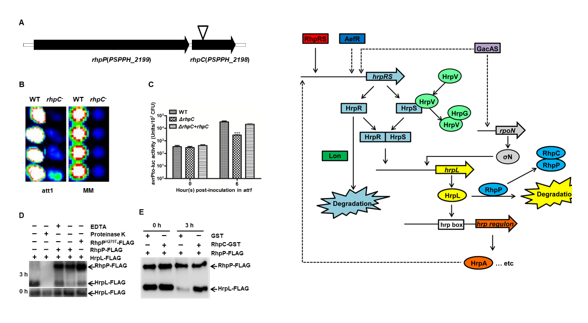The type III secretion system (T3SS), a syringe-like apparatus, is essential for the induction of a hypersensitive response (HR) in resistant and nonhost plants and pathogenicity in susceptible plants. Many gram-negative bacterial pathogens utilize T3SS to deliver effector proteins into host cells for suppressing host immunity. However, the underlying molecular mechanism for regulating the T3SS genes and bacterial fitness needs to be further clarified.
Prof. JIA Yantao’s lab and Prof. FANG Rongxiang’s lab from Institute of Microbiology, Chinese Academy of Sciences, and Prof. Tang Xiaoyan from South China Normal University, revealed that the T3SS regulatory protein HrpL can be modulated by two components of one operon to repress the T3SS gene expression.
They found that RhpP as a metalloprotease can degrade the HrpL protein in cytoplasm. And RhpC as a chaperone, keeps the function of RhpP under control in the cytoplasm by inhibiting the RhpP protease activity and facilitating its translocation to the periplasm. The reduced rhpP transcripts and induced rhpC transcripts in minimal medium serve as double protection that restricts the detrimental RhpP activity to a minimal level in the cytoplasm, which in turn secures the high induction of the T3SS genes.
Interestingly, in almost all sequenced bacterial genomes carrying an RhpC homologue, the rhpC homologous gene is always coupled by the rhpP homologous gene, suggesting co-evolution of the two genes.
Moreover, the presence of RhpC inhibited the RhpP protease activity and the detrimental effect of RhpP on bacterial fitness, suggesting that RhpC is required for the proper function of RhpP.
The result of this study was published in Plos Pathogens (https://www.ncbi.nlm.nih.gov/pubmed/?term=two+components+of+rhpP). LI Kun and ZHU Yanan are the co-first authors, and FANG Rongxiang, JIA Yantao and TANG Xiaoyan are the co-corresponding authors of this study.
The research was supported by grants from the National Key Research and Development Plan (No. 2016YFD0100600) and the National Basic Research Program of China (973 Program 2015CB150600), and grants from National Natural Science Foundation of China (31670127 and 31370161).

Fig 1. Two components of the rhpPC operon coordinately regulate the type III secretion system
Contact:
Prof. JIA Yantao
State Key Laboratory of Plant Genomics, Institute Of Microbiology, Chinese Academy of Sciences, 100101, Beijing, China
E-mail: jiayt@im.ac.cn